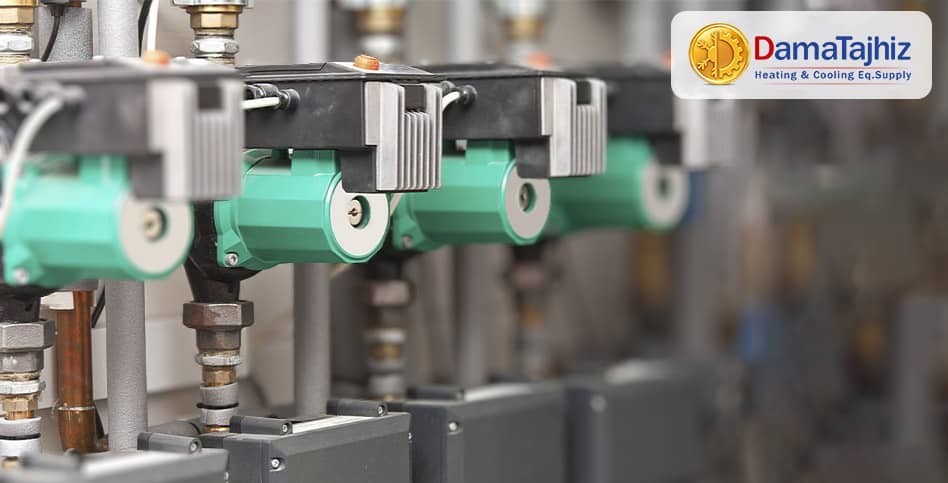As you know, when the name of the pump is mentioned, the first application that comes to mind is the water and gasoline pump. But it is good to know that pumps are produced in different types with different uses, one of the most common types of which is called circulator pumps.
Sir Kole means to turn or rotate, and these pumps are responsible for the circulation of cold or hot water in the air conditioning or central heating systems of buildings. After providing cold or hot water in the refrigeration system or the central system of the buildings, the duty of moving it to the place of heat exchange is the responsibility of the circulator pumps. In order to increase the information of the regular companions of the Damatajhiz site, we have gathered explanations about what is a circulator pump and what it is used for in this article, stay with us.
Click to view brands, models, and different types, find out the price, and Buy A CIRCULATOR PUMP.

How do circulator pumps work?
Circulator pumps are used in small buildings in the package system and in larger buildings in the central engine room system, linearly (installation on the pipe) or ground (installation on the chassis). The way circulator pumps work to circulate the water is that the water is mounted on its impeller, and for this reason, they do not need suction power like water supply and irrigation pumps.
In other words, after providing hot water in the central heating boiler of the building or providing cold water in the refrigeration cycle of the chiller and the cooling system of the building, flowing this hot water or cold water in the pipes (from the engine room to the places of heat exchange) such as radiators, fans Coils, and air generator coils are responsible for circulator pumps.
Basically, circulator pumps are only used to circulate the water of the cooling and heating system in the circuit of this equipment, so the water is riding on their impeller and they do not need the ability to suck water from lower levels (such as irrigation and water supply pumps). For this reason, most circulator pumps, especially in small and medium capacities, work with a maximum speed of 1450 ppm (revolutions per minute).
Types of circulator pumps
Circulator pumps are divided into two general categories according to the way they are placed in the circuit, which we will briefly explain below:
Linear pump (inline): This circulator pump is installed on the pipe and can be single, twin, single round, or even multiple rounds.
Ground pump (on the chassis): in high capacities, due to the use of heavy pumps and electro pumps, the pipes cannot bear their weight. In such a situation, the chassis is placed on the ground and the shock absorber is used to prevent the reduction of vibrations.
Important points in choosing a circulator pump
To choose and buy equipment such as a circulator pump, it is necessary to observe the following points:
- Calculation of the amount of head and flow rate of water in the required circulation of the system
- Determining the type of linear or ground pump
- Circulator pump brand and model
- Pump motor power and speed
- Rib / flange connection
- The diameter of the inlet and outlet pipes of the circulator pump
Note: One of the most important parameters for choosing a circulator pump is its height (head) and flow rate (volume of circulating water G.P.M).
Calculation of circulator capacity
In general, at each section of the heating system, by dividing kilocalories by 2500, the flow rate (GPM) or the volume of water circulating in the same section of the heating system (to calculate the diameter of the pipes and the required flow rate of the circulator pump) is obtained. (Heating Kcal/2500 = BTU /10000 = GPM)
It is also obtained by dividing the kilocalories of each section of the cooling system by the number of 1250 flow rates (GPM) or the volume of water circulating in the same section of the cooling system (to calculate the diameter of the pipes and the required flow rate of the circulator pump). (Cooling Kcal / 1250 = BTU / 5000) = GPM)
One of the most important and decisive factors in the correct calculation of the required head or pressure of the circulator pump is to pay attention to the gravity and natural flow of water inside the vertical pipes of the heating and cooling system of the building. This means that the only function of circulator pumps, which are only used in closed cooling and heating systems, is to compensate for the frictional pressure drop of the water flow along the pipes, connections, valves, and coils of the building's cooling and heating system; Therefore, the engine speed of these pumps is usually lower than the engine speed of the water supply pump of the same project, and this effectively reduces the power and power of the circulator electro pump engine required for the project.
Also, if the REVERSE piping design method is used in medium and large buildings, it is possible to achieve the minimum required power and power of the circulator pump, as well as the most suitable uniform distribution of water flow in the piping of the heating and cooling system of the building by circulator pumps in that project.
What is the use of a circulator?
The main task of these pumps is to compensate for the friction of water pressure in pipes, connections, and heat exchangers, which is why the head of the circulator pump is less than that of the water supply pumps, which causes the electric current and engine speed to be lower. Therefore, these pumps consume less energy than water supply pumps. Circulator pumps have other uses, some of which are mentioned below.
- Pool water pump
- Heating package pump
- Heater pump
- Hot water return pump to coil or double wall source
- Boiler hot water supply pump to coil or double wall spa source
- And ...
Circulator pump installation location
The location of circulator pumps in central heating systems is on the return pipe of the central heating system to the engine room boiler, or on a carefully leveled chassis.
Circulator pumps are usually installed in the return water circuit of cooling or heating systems. In other words, they are placed before the central heating boiler in the heating systems and before the chiller in the cooling systems, so that the water output of the circulator pumps in the heating systems enters the boiler, then flows through the radiators and fan coils, and in the cooling systems, the water output of the circulator pump goes to the chiller evaporator. And then enters the fan coil and air conditioner coil.
To return the unused hot water in the building's spa piping, it is necessary to install the hot water return pump before the coil or double-wall source on the building's hot water return pipe.
Usually, the hot water return pump used for the double-wall source or even the coil source of the building's motor house is considered to be a 1-inch or 1/4-inch linear pump of GRUNDFOS, DAB, or WILO brand.
Features of circulator pumps
Circulator pumps have a wide range of features that are discussed below:
Production of circulator pumps in sizes 0.5 to 6 inches
Production in single, double, triple, and four different rounds
The circulator pump has little noise during operation
In the category of consumption A and B, there is an electro-pump energy label
The speed of circulator electro pumps is usually 1500 rpm, and of course, in some cases, circulator pumps with 2900 RPM may be used.
And ...
The best circulator pump brands
In order to easily choose and buy a circulator pump, after determining the head (H) and flow rate (GPM), you must first determine the brand and required capacity of the pump and find the list of the best Iranian and foreign brands with just a small search. Below are some of these brands:
- Semnan Energy
- Grundfos
- DAB
- Lora
- WILO
- Armstrong
- Bell and Cast Tehran
- Time
- Leo
- Levitra
- Pampering
Conclusion
Circulator pumps are known as equipment for circulating water (hot or cold), which are used in cooling and heating distribution systems to provide the required thermal and cooling load of buildings and cooling towers. Of course, the pumps are divided into two groups with different functions, considering the placement mode in the circuits.
You can also read the article COMPARISON OF LINEAR AND GROUND CIRCULATOR PUMP for more information.
Final speech
The specialized collection of Demataheheez (the first and most reliable authority for purchasing building facilities and all air conditioning devices, since 2013 and has 3 valid business licenses), all kinds of circulator pumps and hundreds of other products with the guarantee of originality of the goods, after-sales service, valid warranty and Offers a reasonable price. For more information, you can contact the heating experts during office hours by phone number: +98 2188822550.

We are waiting for your call and look forward to meeting you at the DAMATAJHIZ group
By sharing the above article on social networks, let your friends know about its essential content.

